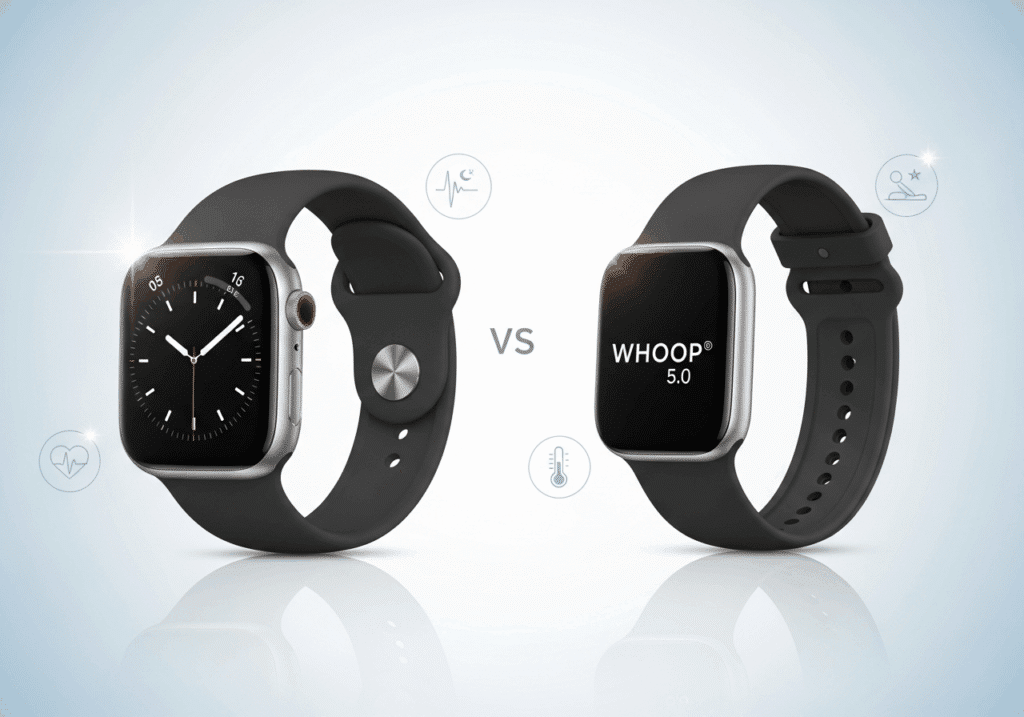AI Wellness Apps Transform Personalized Healthcare in 2025
From generic tips to precision insights: how personalized health AI, next-gen wearables, and health tracking apps are reshaping daily habits, clinical workflows, and the wellness economy. What is “personalized health AI”?
Personalized health AI uses data from wearables (heart rate, HRV, sleep, activity), lifestyle inputs, and sometimes lab or microbiome markers to generate individualized guidance on sleep, stress, recovery, nutrition, and training. Unlike generic advice, AI models learn your baseline and adapt recommendations in real time.
Context on the compute race enabling smarter wellness apps: OpenAI’s multi-billion AWS deal, Nvidia Blackwell demand surge, and Samsung’s heat-pass thermal breakthrough.
1) Wellness Revolution: From Generic Advice to Personalized Insights
The wellness playbook used to be one-size-fits-all: walk more, eat better, stress less. In 2025, leading wellness technology trends flip that script. Wearables capture tens of thousands of physiological datapoints per day; health tracking apps run AI models on top to discover what helps you sleep deeper, recover faster, and avoid overtraining. Instead of “10,000 steps,” your AI coach might suggest moving sunlight exposure earlier, shifting dinner 90 minutes, and replacing a HIIT day with mobility based on three days of suppressed HRV.
This behavioral precision increases adherence and perceived value. It’s also sticky: when users see readiness, sleep, and mood scores improve, they keep devices on—and subscriptions active. Macro forces amplify the shift: cheaper on-device inference, bigger cloud contracts, and new silicon (see also our chip policy explainer on US Nvidia export restrictions) are all making real-time insights faster and more reliable.
2) Technology Breakdown: Wearables, AI Health Coaches, Predictive Analytics
Quick Comparison: Apple Watch vs Oura Ring vs WHOOP (2025 Models)

As personalized health AI gains traction, consumers often compare leading wearables for data accuracy, comfort, and ecosystem value. Below is a concise breakdown of the top three devices dominating the wellness technology trends market.
| Feature | Apple Watch Series 10 | Oura Ring Gen 4 | WHOOP 5.0 Strap |
|---|---|---|---|
| Primary Focus | Activity, ECG, safety, overall health | Sleep, recovery, readiness insights | Strain, recovery, stress monitoring |
| Key Sensors | HR, HRV, ECG, SpO₂, skin temp | HRV, temp, blood oxygen, movement | HRV, skin temp, motion, SpO₂ |
| Battery Life | ~36 hours (fast charge) | 4–5 days | 4–5 days (on-strap charge) |
| AI Coaching Strength | Integrated with Apple Health & Fitness+ | Highly refined readiness & recovery AI | Best-in-class strain/recovery algorithm |
| Subscription Model | Optional Fitness+ and Apple One | Premium data insights tier (optional) | Mandatory membership for full data |
| Ideal For | Everyday health & safety tracking | Sleep, recovery, lifestyle optimization | Athletes & data-driven performance |
*All specifications based on manufacturer data as of Q4 2025. Battery life and accuracy vary by usage and update version.*
These three devices illustrate the AI-driven convergence of consumer wellness and medical-grade monitoring. Apple leverages its healthcare integrations, Oura continues to dominate sleep analytics, and WHOOP leads athletic recovery personalization. Together, they define the benchmark for the personalized health revolution.
Wearables: the sensing layer powering insights
Apple Watch, Oura Ring, and WHOOP normalize all-day sensing—heart rate, HRV, sleep stages, temperature trends, and respiration. The 2025 cohort adds smoother cuffless BP trends and early warning prompts (e.g., readiness or illness risk). Crucially, these devices now power predictive features—injury risk flags for runners, menstrual-phase-aware training blocks, and recovery-first scheduling that adapts week to week.
AI coaches: from tracking to actionable coaching
The modern AI health coach doesn’t dump charts—it offers next steps. Based on 90 days of sleep and activity, it might deliver a phased wind-down protocol; if your HRV tanks after late meals, it nudges meal timing and caffeine curfews; if stress spikes, it serves a 4-minute breathing routine rather than a long meditation you’ll skip. This is personalization that respects time, context, and preference.
Predictive analytics with safety rails
Mature platforms calibrate to your baseline, explain confidence levels, and escalate medically relevant patterns to clinicians or virtual care. As models grow, thermal and cloud efficiency matter for latency and cost (see Blackwell demand and mega cloud deals).
Technology Adoption Statistics (2025 Snapshot)
- Smartwatches and rings lead daily use for sleep, recovery, and readiness scoring across fitness and general wellness users.
- AI features (adaptive plans, readiness/strain predictions) are standard in top wellness apps and drive premium-tier conversion.
- Blended models—device + app + human coach—show materially higher retention versus tracker-only approaches.
3) Consumer Adoption: Demographics, Usage Patterns, Spending

Who’s using personalized health tools? Gen Z and Millennials skew performance- and mood-driven; Gen X focuses on productivity and longevity; Boomers prefer peace-of-mind monitoring. Willingness to pay rises when advice clearly maps to personal outcomes: better sleep, fewer injuries, steadier energy. Annual spends of $200–$500 (device + premium app) are common among engaged users, with “optimizer” segments stacking subscriptions (sleep, nutrition, breathwork).
What drives retention? Passive sensing, clear wins in the first 2–3 weeks, and minimal manual logging. Social challenges and streaks help, but the strongest adhesive is tangible improvement that the user can feel and see in the metrics.
Consumer Spending & ROI: Where Value Shows Up
- Sleep dividends: +15–20 minutes of quality sleep often yields noticeable daytime gains—fastest “feelable” ROI.
- Injury avoidance: One avoided overuse injury can justify a year of subscription fees for runners and lifters.
- Fuel timing: Better glycemic stability reduces afternoon crashes; some users report fewer “lost” work hours.
- Stress-down, readiness-up: Small daily nudges compound into sustainable training progress.
For a macro lens on how AI markets influence consumer tech investment cycles, see our analysis of AI-driven equity returns and cross-asset spillovers during risk-off turns (crypto drawdowns).
4) Medical Integration: Bringing Consumer Health Data into Care
Health systems increasingly pilot remote patient monitoring (RPM) and clinician dashboards that summarize patient-generated health data (PGHD). The best workflows don’t swamp EHRs with raw streams; they translate volatility into trends and flags, with audit trails and patient messaging. Expect more “wellness-to-clinical” bridges for sleep apnea screening, arrhythmia detection, and nocturnal breathing irregularities as validation improves.
Providers remain cautious about accuracy and alert fatigue. Leading platforms publish whitepapers, collaborate with academic labs, and route sensitive alerts to virtual triage rather than leaving users to self-diagnose. As AI features cross into diagnosis or treatment, features move through regulatory pathways, while wellness-only guidance remains clearly labeled.
5) Privacy Considerations: Data Security, Consent, and Fairness
Personalized wellness apps ingest sensitive data—sleep timing, menstrual phases, stress patterns—and sometimes location. Trust hinges on privacy by design: minimization, on-device processing where possible, encryption in transit/at rest, and transparent consent toggles. Clear distinctions between insights and marketing use are non-negotiable.
Algorithmic fairness matters. If training data skews young or athletic, older or multi-morbid users may receive sub-optimal guidance. Leaders invest in diverse datasets, bias testing, and human-in-the-loop review. For upstream forces that shape device capability and cost, see our policy and chips coverage: semiconductor export restrictions.
6) Future Evolution: Next-Gen Personalization and Accessibility
The next wave is multimodal personalization: combining wearables with environment (light, air quality), labs (lipids, glucose), and microbiome to create adaptive protocols. AI coaches will be more conversational, anticipate lapses, and deliver just-in-time micro-habits. Accessibility improves as premium sensors trickle down and as employers/insurers fund prevention.
Cross-sector breakthroughs will keep accelerating wellness. Bigger models and better data help medical research too—see our health desk’s coverage of AI-designed antibiotics for a glimpse of how AI reshapes discovery cycles.
Wellness Lifestyle Prompts (Try These This Week)
- Recovery reality check: Three days of lower HRV? Swap today’s HIIT for mobility + 5-minute breathwork and reassess tomorrow.
- Sleep experiment: Set a 1 p.m. caffeine curfew and a 90-minute wind-down for 7 days. Do deep-sleep minutes rise?
- Fuel timing: Move your largest meal to midday for a week. Track afternoon energy and readiness score changes.
Editor’s note: Wellness apps do not replace medical care. If you receive a concerning alert, consult a licensed clinician.
Explore more in our Technology, Health, and Crypto sections.